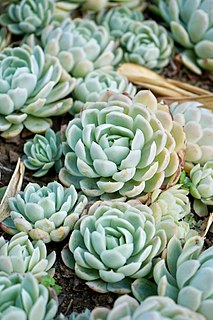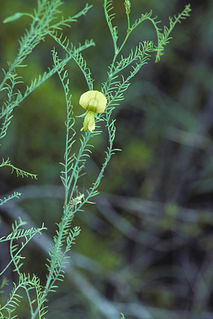
The Crassulaceae, also known as the stonecrop family or the orpine family, are a diverse family of dicotyledon flowering plants characterized by succulent leaves and a unique form of photosynthesis, known as Crassulacean acid metabolism (CAM). Flowers generally have five floral parts. Crassulaceae are usually herbaceous but there are some subshrubs, and relatively few treelike or aquatic plants. Crassulaceae are a medium size monophyletic family in the core eudicots, among the order Saxifragales, whose diversity has made infrafamilial classification very difficult. The family includes approximately 1,400 species and 34–35 genera, depending on the circumscription of the genus Sedum, and distributed over three subfamilies. Members of the Crassulaceae are found worldwide, but mostly in the Northern Hemisphere and southern Africa, typically in dry and/or cold areas where water may be scarce. although a few are aquatic.

Cosmos is a genus, with the same common name of cosmos, consisting of flowering plants in the sunflower family.

Nolina is a genus of tropical xerophytic flowering plants, with the principal distribution being in Mexico and extending into the southern United States.

Sedum is a large genus of flowering plants in the family Crassulaceae, members of which are commonly known as stonecrops. The genus has been described as containing up to 600 species, subsequently reduced to 400–500. They are leaf succulents found primarily in the Northern Hemisphere, but extending into the southern hemisphere in Africa and South America. The plants vary from annual and creeping herbs to shrubs. The plants have water-storing leaves. The flowers usually have five petals, seldom four or six. There are typically twice as many stamens as petals. Various species formerly classified as Sedum are now in the segregate genera Hylotelephium and Rhodiola.

Polianthes is a formerly recognized genus of plants in family Asparagaceae, subfamily Agavoideae. molecular phylogenetic studies showed that Polianthes is embedded within the larger genus Agave, which has been expanded to include it. One of its former members is the tuberose, Agave amica, formerly Polianthes tuberosa, a plant that is commonly used in perfume making.

Echeveria is a large genus of flowering plants in the family Crassulaceae, native to semi-desert areas of Central America, Mexico and northwestern South America.

Arracacia is a genus of flowering plant in the Apiaceae. It is endemic to the Americas. The most important member of the genus economically is the arracacha, Arracacia xanthorrhiza.

Argythamnia is a genus of plants of the family Euphorbiaceae first described as a genus in 1756. They are known commonly as silverbushes.

Brongniartia is a genus of leguminous plants, first named by Kunth after the French botanist Adolphe Brongniart.

Dalea is a genus of flowering plants in the legume family, Fabaceae. Members of the genus are commonly known as prairie clover or indigo bush. Its name honors English apothecary Samuel Dale (1659–1739). They are native to the New World, where they are distributed from Canada to Argentina. Nearly half of the known species are endemic to Mexico. Two species of Dalea have been considered for rangeland restoration.

Rhodiola is a genus of perennial plants in the family Crassulaceae that resemble Sedum and other members of the family. Like sedums, Rhodiola species are often called stonecrops. Some authors merge Rhodiola into Sedum.

Marina is a genus of legumes. They are known as the false prairie clovers. Unlike the related prairie clovers, which bear two ovules per fruit, false prairie clovers bear only one ovule per fruit.
Senna wislizeni is commonly called Wislizenus' senna or shrubby senna. Formerly in the "wastebin taxon" Cassia sensu lato, it is now placed in the genus Senna or sometimes separated in Palmerocassia together with Senna unijuga.
Lenophyllum is a genus of flowering plants in the family Crassulaceae. The roughly seven species it contains are distributed in Texas in the United States and northeastern Mexico. Some authorities place it in the genus Sedum. Plants in this genus are distinguished from Sedum species by the presence of terminal inflorescences, erect petals, and opposite leaves. The name is derived from the Ancient Greek words ληνός (lenos), meaning "trough", and φύλλον (phyllon), meaning "leaf."

Acaciella is a Neotropical genus of flowering plants in the legume family, Fabaceae, and its subfamily Mimosoideae. Its centre of diversity is along the Mexican Pacific coast. They are unarmed, have no extrafloral nectaries and the polyads of their pollen are 8-celled. Though its numerous free stamens is typical of Acacia s.l., it has several characteristics in common with genus Piptadenia. Its pollen and free amino acids resemble that of Senegalia. Molecular studies place it sister to a monophyletic clade comprising elements of genus Acacia, and the tribe Ingeae. A nectary ring is present between the stamens and ovary, in common with Acacia subg. Aculeiferum.

Montanoa is a genus of flowering plants in the sunflower tribe within the daisy family.
This is a list of plants found in the Sierra de Manantlán Biosphere Reserve. The reserve straddles the Mexican states of Colima and Jalisco. It is located in the transition between the Nearctic and Neotropical realms and encompasses parts of the Sierra Madre del Sur, with a wide range of altitudes, climates and soils. The effects of tectonic and volcanic activities and erosion are notable within the reserve.

Sempervivoideae is the largest of three subfamilies in the Saxifragales family Crassulaceae, with about 20–30 genera with succulent leaves. Unlike the two smaller subfamilies, it is distributed in temperate climates.
This page is based on this
Wikipedia article Text is available under the
CC BY-SA 4.0 license; additional terms may apply.
Images, videos and audio are available under their respective licenses.














